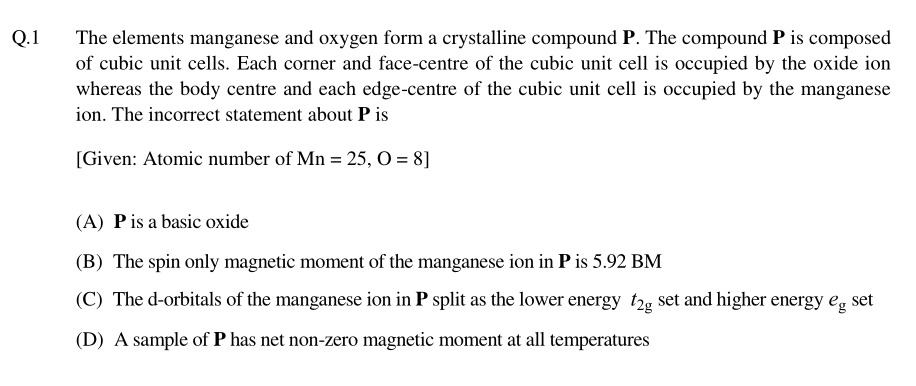Question
Question: The elements manganese and oxygen form a crystalline compound **P**. The compound **P** is composed ...
The elements manganese and oxygen form a crystalline compound P. The compound P is composed of cubic unit cells. Each corner and face-centre of the cubic unit cell is occupied by the oxide ion whereas the body centre and each edge-centre of the cubic unit cell is occupied by the manganese ion. The incorrect statement about P is
[Given: Atomic number of Mn = 25, O = 8]

P is a basic oxide
The spin only magnetic moment of the manganese ion in P is 5.92 BM
The d-orbitals of the manganese ion in P split as the lower energy t2g set and higher energy eg set
A sample of P has net non-zero magnetic moment at all temperatures
A sample of P has net non-zero magnetic moment at all temperatures
Solution
The compound P is formed by manganese ions and oxide ions. The unit cell is cubic. Oxide ions (O²⁻) are at each corner and face-centre of the cubic unit cell. Number of O²⁻ ions per unit cell = (8 corners * 1/8 per corner) + (6 face-centres * 1/2 per face-centre) = 1 + 3 = 4.
Manganese ions (Mnⁿ⁺) are at the body centre and each edge-centre. Number of Mnⁿ⁺ ions per unit cell = (1 body centre * 1 per body centre) + (12 edge-centres * 1/4 per edge-centre) = 1 + 3 = 4.
The ratio of Mn ions to O²⁻ ions is 4:4, which simplifies to 1:1. The formula of the compound P is MnO. Since the oxide ion is O²⁻, the oxidation state of manganese in MnO must be +2. The manganese ion is Mn²⁺.
Now let's evaluate each statement:
(A) P is a basic oxide. MnO is a metallic oxide. Oxides of metals are generally basic or amphoteric. Oxides of transition metals in lower oxidation states (+2, +3) are typically basic. MnO reacts with acids, confirming its basic nature. For example, MnO + 2HCl → MnCl₂ + H₂O. This statement is correct.
(B) The spin only magnetic moment of the manganese ion in P is 5.92 BM. The manganese ion is Mn²⁺. The atomic number of Mn is 25. Electronic configuration of Mn: [Ar] 3d⁵ 4s². Electronic configuration of Mn²⁺: [Ar] 3d⁵. In the 3d subshell, there are 5 orbitals. According to Hund's rule, the 5 electrons occupy each orbital singly, resulting in 5 unpaired electrons (n=5). The spin-only magnetic moment (μ) is given by the formula μ = √[n(n+2)] BM. For n=5, μ = √[5(5+2)] = √[5 * 7] = √35 BM. √35 ≈ 5.916 BM, which is approximately 5.92 BM. This statement is correct.
(C) The d-orbitals of the manganese ion in P split as the lower energy t2g set and higher energy eg set. In MnO, the structure is rock salt type (O²⁻ forms an FCC lattice, and Mn²⁺ occupies all octahedral holes). The Mn²⁺ ion is surrounded by six O²⁻ ions in an octahedral coordination environment. In an octahedral crystal field, the five degenerate d-orbitals split into two sets: the lower energy t₂g set (dxy, dyz, dxz) and the higher energy e_g set (dz², dx²-y²). This statement is correct.
(D) A sample of P has net non-zero magnetic moment at all temperatures. MnO is known to be an antiferromagnetic material. In antiferromagnetic materials, the magnetic moments of adjacent ions align in opposite directions. Below a certain temperature called the Néel temperature (T_N), this antiparallel alignment is ordered, resulting in a net magnetic moment of zero for the sample. Above the Néel temperature, the material becomes paramagnetic, where the individual magnetic moments exist but are randomly oriented, leading to a net magnetic moment of zero in the absence of an external magnetic field. A spontaneous net non-zero magnetic moment exists only in ferromagnetic or ferrimagnetic materials. Since MnO is antiferromagnetic, its net magnetic moment is zero below T_N and zero (in the absence of an external field) above T_N. Therefore, the statement that it has a net non-zero magnetic moment at all temperatures is incorrect.
The incorrect statement is (D).
